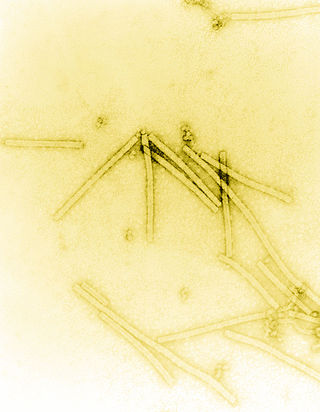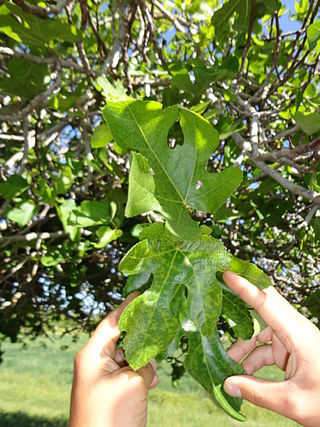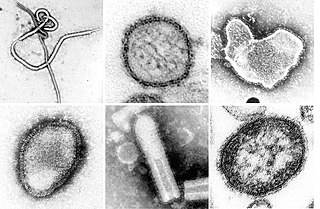
Tobacco mosaic virus (TMV) is a positive-sense single-stranded RNA virus species in the genus Tobamovirus that infects a wide range of plants, especially tobacco and other members of the family Solanaceae. The infection causes characteristic patterns, such as "mosaic"-like mottling and discoloration on the leaves. TMV was the first virus to be discovered. Although it was known from the late 19th century that a non-bacterial infectious disease was damaging tobacco crops, it was not until 1930 that the infectious agent was determined to be a virus. It is the first pathogen identified as a virus. The virus was crystallised by W.M. Stanley. It has a similar size to the largest synthetic molecule, known as PG5.

The mumps virus (MuV) is the virus that causes mumps. MuV contains a single-stranded, negative-sense genome made of ribonucleic acid (RNA). Its genome is about 15,000 nucleotides in length and contains seven genes that encode nine proteins. The genome is encased by a capsid that is in turn surrounded by a viral envelope. MuV particles, called virions, are pleomorphic in shape and vary in size from 100 to 600 nanometers in diameter. One serotype and twelve genotypes that vary in their geographic distribution are recognized. Humans are the only natural host of the mumps virus.

Tomato bushy stunt virus (TBSV) is a virus of the tombusvirus family. It was first reported in tomatoes in 1935 and primarily affects vegetable crops, though it is not generally considered an economically significant plant pathogen. Depending upon the host, TBSV causes stunting of growth, leaf mottling, and deformed or absent fruit. The virus is likely to be soil-borne in the natural setting, but can also be transmitted mechanically, for example through contaminated cutting tools. TBSV has been used as a model system in virology research on the life cycle of plant viruses, particularly in experimental infections of the model host plant Nicotiana benthamiana.

Potyvirus is a genus of positive-strand RNA viruses in the family Potyviridae. Plants serve as natural hosts. Like begomoviruses, members of this genus may cause significant losses in agricultural, pastoral, horticultural, and ornamental crops. More than 200 species of aphids spread potyviruses, and most are from the subfamily Aphidinae. The genus contains 190 species and potyviruses account for about thirty percent of all currently known plant viruses.

RNA-dependent RNA polymerase (RdRp) or RNA replicase is an enzyme that catalyzes the replication of RNA from an RNA template. Specifically, it catalyzes synthesis of the RNA strand complementary to a given RNA template. This is in contrast to typical DNA-dependent RNA polymerases, which all organisms use to catalyze the transcription of RNA from a DNA template.
Drosophila X virus (DXV) belongs to the Birnaviridae family of viruses. Birnaviridae currently consists of three genera. The first genus is Entomobirnavirus, which contains DXV. The next genus is Aquabirnavirus, containing infectious pancreatic necrosis virus (IPNV). The last genus is Avibirnavirus, which contains infectious bursal disease virus (IBDV). All of these genera contain homology in three specific areas of their transcripts. The homology comes from the amino and carboxyl regions of preVP2, a small 21-residue-long domain near the carboxyl terminal of VP3, and similar small ORFs sequences.
Potato mop-top virus (PMTV) is a plant pathogenic virus transmitted through the vector Spongospora subterranea that affects potatoes. PMTV belongs to family of Virgaviridae, and the genus Pomovirus. The virus was first identified in 1966 by Calvert and Harrison in Britain, and is now reported in many other potato cultivating regions of the world including U.S.A., Canada, China, Pakistan, Japan, South American countries and many parts of Europe. Many disease management systems have been found to be ineffective against the virus, although a combination of sanitation and vector controls seems to work well.
Potato virus X (PVX) is a plant pathogenic virus of the family Alphaflexiviridae and the order Tymovirales.
Potato virus Y (PVY) is a plant pathogenic virus of the family Potyviridae, and one of the most important plant viruses affecting potato production.
Sweet potato feathery mottle virus (SPFMV) is a member of the genus Potyvirus in the family Potyviridae. It is most widely recognized as one of the most regularly occurring causal agents of sweet potato viral disease (SPVD) and is currently observed in every continent except Antarctica. The number of locations where it is found is still increasing; generally, it is assumed that the virus is present wherever its host is. The virus has four strains that are found in varying parts of the world.

Marnaviridae is a family of positive-stranded RNA viruses in the order Picornavirales that infect various photosynthetic marine protists. Members of the family have non-enveloped, icosahedral capsids. Replication occurs in the cytoplasm and causes lysis of the host cell. The first species of this family that was isolated is Heterosigma akashiwo RNA virus (HaRNAV) in the genus Marnavirus, which infects the toxic bloom-forming Raphidophyte alga, Heterosigma akashiwo. As of 2021, there are twenty species across seven genera in this family, as well as many other related virus sequences discovered through metagenomic sequencing that are currently unclassified.

Fig mosaic emaravirus (FMV) is a segmented, negative sense, single-stranded RNA virus that is determined to be the causal agent of fig mosaic disease (FMD) in fig plants, Ficus carica. It is a member of the genus Emaravirus and order Bunyavirales and is transmitted mainly by the eriophyid mite Aceria ficus. FMV can cause a range of symptoms varying in severity, including leaf chlorosis, deformity, and mosaic or discoloration patterns, as well as premature fruit drop.
Citrus leprosis(CL) is an economically important viral disease affecting citrus crops. This emerging disease is widely distributed in South and Central America, from Argentina to Mexico. The disease is associated with up to three different non-systemic viruses, which cause similar symptoms in the citrus hosts and are transmitted by the same vector, mites of the genus Brevipalpus; although they have vastly different genomes. Citrus leprosis virus nuclear type (CiLV-N) is found in the nuclei and cytoplasm of infected cells, while Citrus leprosis virus cytoplasmic type (CiLV-C) is found in the endoplasmic reticulum. In 2012, a new virus causing similar symptoms was found in Colombia and it was named Citrus leprosis virus cytoplasmic type 2 (CiLV-C2) due to its close similarity to CiLV-C. The cytoplasmic type viruses are the most prevalent and widely distributed of the three species.
Lily virus X (LVX) is a pathogenic ssRNA(+) plant virus of the family Alphaflexiviridae and the order Tymovirales.
Cassava brown streak virus is a species of positive-strand RNA viruses in the genus Ipomovirus and family Potyviridae which infects plants. Member viruses are unique in their induction of pinwheel, or scroll-shaped inclusion bodies in the cytoplasm of infected cells. Cylindrical inclusion bodies include aggregations of virus-encoded helicase proteins. These inclusion bodies are thought to be sites of viral replication and assembly, making then an important factor in the viral lifecycle. Viruses from both the species Cassava brown streak virus and Ugandan cassava brown streak virus (UCBSV), lead to the development of Cassava Brown Streak Disease (CBSD) within cassava plants.

Negative-strand RNA viruses are a group of related viruses that have negative-sense, single-stranded genomes made of ribonucleic acid (RNA). They have genomes that act as complementary strands from which messenger RNA (mRNA) is synthesized by the viral enzyme RNA-dependent RNA polymerase (RdRp). During replication of the viral genome, RdRp synthesizes a positive-sense antigenome that it uses as a template to create genomic negative-sense RNA. Negative-strand RNA viruses also share a number of other characteristics: most contain a viral envelope that surrounds the capsid, which encases the viral genome, −ssRNA virus genomes are usually linear, and it is common for their genome to be segmented.

The Blueberry mosaic associated ophiovirus (B1MaV) is a plant virus which infects blueberry plants, causing a discoloration of the leaves of the plants in a mosaic-like pattern. The disease is found in blueberry plants in many regions of North America, as well as South America, Europe, New Zealand, and South Africa. Within these regions the virus is most often found in high blueberry-yielding areas, but can be spread to other locations. Blueberry mosaic associatedophiovirus is one of seven species in the genus Ophiovirus. It is a member of the Aspiviridae family, in the Serpentovirales order, and in the Milnevircetes class. The Ophioviridae viruses are characterized by a flexible and elongated nucleocapsid that is composed mostly of filamentous structures and is helically symmetrical. It also has a non-enveloped protein capsid that is capable of coiling around itself allowing for a super-coiled structure and the helical symmetry. The virus has the potential to be symptomatic or asymptomatic within plants causing the display of symptoms in only a few plants, but the ability to transmit the virus unknowingly in many plants. B1MaV often remains asymptomatic for long periods of time after initial infection allowing for blind transmission.

Orthornavirae is a kingdom of viruses that have genomes made of ribonucleic acid (RNA), including genes which encode an RNA-dependent RNA polymerase (RdRp). The RdRp is used to transcribe the viral RNA genome into messenger RNA (mRNA) and to replicate the genome. Viruses in this kingdom share a number of characteristics which promote rapid evolution, including high rates of genetic mutation, recombination, and reassortment.
Rio Negro virus is an alphavirus that was first isolated in Argentina in 1980. The virus was first called Ag80-663 but was renamed to Rio Negro virus in 2005. It is a former member of the Venezuelan equine encephalitis complex (VEEC), which are a group of alphaviruses in the Americas that have the potential to emerge and cause disease. Río Negro virus was recently reclassified as a distinct species. Closely related viruses include Mucambo virus and Everglades virus.
Planarian secretory cell nidovirus (PSCNV) is a virus of the species Planidovirus 1, a nidovirus notable for its extremely large genome. At 41.1 kilobases, it is the largest known genome of an RNA virus. It was discovered by inspecting the transcriptomes of the planarian flatworm Schmidtea mediterranea and is the first known RNA virus infecting planarians. It was first described in 2018.









